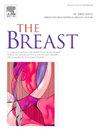前哨淋巴结活检遗漏后部分乳房放疗:是替代全乳房放疗的有效方法吗?全乳房照射与部分乳房照射对前哨淋巴结区域的剂量分析
IF 7.9
2区 医学
Q1 OBSTETRICS & GYNECOLOGY
引用次数: 0
摘要
背景:前哨淋巴结活检(SLNB)可以安全地在选定的早期临床淋巴结阴性乳腺癌(BC)患者中省略。虽然这些患者也是部分乳房照射(PBI)的候选人,但PBI对前哨淋巴结区域(sln)和腋窝水平的剂量学影响尚不清楚。方法在本研究中,通过术前和术后影像学对100例BC患者的sln进行了识别和轮廓。根据ESTRO指南绘制腋窝水平轮廓。我们分析了不同技术(3d适形放射治疗[3D-CRT] vs.体积调制弧线治疗[VMAT])、深度吸气憋气[DIBH] vs.自由呼吸[FB])的全乳照射(WBI)和PBI在SLN (n = 9000数据点)和腋窝水平(n = 270数据点)的剂量分布,以及解剖变化(乳房大小、肿瘤部位和乳房上缘)。结果swbi为65%的sln提供了完全的治疗剂量覆盖(95%的处方剂量),而PBI仅为10% (3D-CRT)和3% (VMAT)。与FB相比,DIBH显著降低了SLN和腋窝水平的剂量分布。在内侧/中央肿瘤、较小乳房和乳房上缘较低的患者中,也观察到较低的附带剂量覆盖率。结论PBI对SLN的偶发剂量明显低于WBI。由于INSEMA和SOUND试验中的患者主要采用WBI治疗,因此不应将遗漏SLNB与PBI相结合视为标准方法,需要进一步研究。本文章由计算机程序翻译,如有差异,请以英文原文为准。
Partial breast irradiation after sentinel lymph node biopsy omission: Is it a valid alternative to whole breast Irradiation? Analysis of the dose to the sentinel lymph node region during whole breast irradiation vs. partial breast irradiation
Background
Sentinel lymph node biopsy (SLNB) can be safely omitted in selected early-stage, clinically node-negative breast cancer (BC) patients. While these patients are also candidates for partial breast irradiation (PBI), the dosimetric effects of PBI on the sentinel lymph node region (SLNs) and axillary levels remain unclear.
Methods
In this study, SLNs were identified and contoured in 100 BC patients using pre- and postoperative imaging. Axillary levels were contoured following ESTRO guidelines. Dose distribution to the SLN (n = 9000 data points) and axillary levels (n = 270 data points) were analyzed for whole breast irradiation (WBI) and PBI across different techniques (3D-conformal radiation therapy [3D-CRT] vs. volumetric modulated arc therapy [VMAT]), deep inspiration breath-hold [DIBH] vs. free breathing [FB]), and anatomical variations (breast size, tumor site, and upper breast border).
Results
WBI provided full therapeutic dose coverage (>95 % of the prescribed dose) to 65 % of SLNs, compared to only 10 % (3D-CRT) and 3 % (VMAT) with PBI. DIBH significantly reduced dose distribution to SLN and axillary levels compared to FB. Lower incidental dose coverage was also observed in patients with medial/central tumors, smaller breasts, and lower upper breast borders.
Conclusion
These results demonstrate that PBI delivers substantially lower incidental dose to the SLN than WBI. Since patients in the INSEMA and SOUND trials were predominantly treated with WBI, combining SLNB omission with PBI should not be considered a standard approach and warrants further investigation.
求助全文
通过发布文献求助,成功后即可免费获取论文全文。
去求助
来源期刊

Breast
医学-妇产科学
CiteScore
8.70
自引率
2.60%
发文量
165
审稿时长
59 days
期刊介绍:
The Breast is an international, multidisciplinary journal for researchers and clinicians, which focuses on translational and clinical research for the advancement of breast cancer prevention, diagnosis and treatment of all stages.
 求助内容:
求助内容: 应助结果提醒方式:
应助结果提醒方式:


